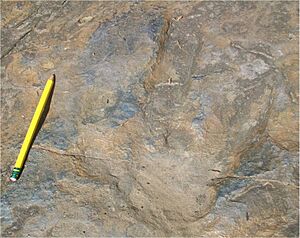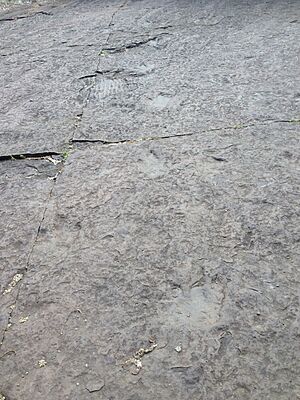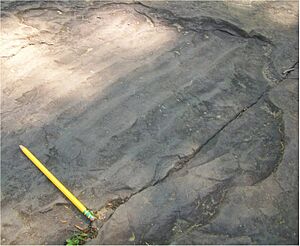Dinosaur Footprints Reservation facts for kids
Dinosaur Footprints is a special nature reserve in Holyoke, Massachusetts, USA. It's an 8-acre area of natural land that was bought for everyone to enjoy in 1935. This reserve is looked after by a group called The Trustees of Reservations, with help from the Massachusetts Department of Conservation and Recreation. They also work with Holyoke Gas and Electric to protect the fossils and plants along the river.
This place is famous because it has some of the very first dinosaur tracks ever studied by scientists, way back in 1836! You can still see hundreds of these tracks today. They were made by at least four different kinds of dinosaurs that walked on two legs. Scientists have also found other fossils here, like traces of ancient worms, fish, and even plants. The way many of the dinosaur tracks line up helped scientists realize that some dinosaurs might have traveled together in groups.
Contents
What Are Fossil Footprints?
The main attraction at Dinosaur Footprints are the amazing fossil footprints. These tracks were made about 200 million years ago, during a time called the Early Jurassic period. Back then, the area we now call the Connecticut River Valley was a warm, wet place with lots of lakes and swamps.
Large, two-legged, meat-eating dinosaurs, some as long as 20 feet, walked across ancient mudflats. They left their footprints in the soft mud. Over millions of years, this mud turned into rock, preserving the tracks for us to see today.
Who Studied These Tracks?
In the 1800s, this area became very important to paleontologists, who are scientists who study fossils. It was especially popular with ichnologists, who focus on fossil tracks.
One of the first to study these tracks was Edward Hitchcock, a professor from Amherst College. He had a new idea that dinosaurs might have been more like "reptilian birds" than cold-blooded reptiles. People even joked about it, calling the dinosaurs "the Giant Turkeys of Prof. Hitchcock."
Many other famous scientists have visited this site. Thomas Henry Huxley came in 1876. Later, John Ostrom from Yale University mapped the site. He found 134 tracks and suggested that the dinosaurs were "gregarious," meaning they lived in groups or herds. He identified tracks from small, medium, and large meat-eating dinosaurs, giving them scientific names like Grallator cuneatus (3 to 5 inches long) and Eubrontes giganteus (11 to 13 inches long).
More recent studies by Patrick Getty and Aaron Judge found even more tracks – at least 787! They noticed that the large Eubrontes giganteus tracks often run parallel to ancient ripple marks in the stone. This suggests the dinosaurs might have been walking along the shoreline, rather than always in a group.
Besides dinosaur tracks, scientists have also found footprints from early plant-eating dinosaurs called Anomoepus scambus. There are even tracks from ancient crocodile-like creatures called Batrachopus.
William J. Miller, a professor from Smith College, wrote about how special this place is. He said that no other place in the world has so many perfectly preserved ancient animal tracks. He even described being able to step in a series of eleven footprints, just like a giant dinosaur did!
Exploring the Reserve
A dirt path leads you from the entrance right to where the dinosaur footprints are. Besides the clear dinosaur tracks, you can also see imprints left by prehistoric plants and traces of ancient worms. You can even spot delicate ripple marks from an old pool, all preserved in stone near the river.
These amazing fossils are found not just in the reserve itself, but also on nearby land managed by the Trustees of Reservations and Holyoke Gas and Electric. There's another place to see dinosaur tracks in nearby Granby, Massachusetts. And Amherst College has a museum that displays dinosaur footprints found in South Hadley.
Planning Your Visit
The Dinosaur Footprints reserve is open during daylight hours from April 1 to November 30. They even have educational programs for children!
For your safety, please know that you cannot cross the railroad tracks. This means there is no legal access to the Connecticut River from the reserve. Mountain biking is not allowed, and if you bring a dog, it must be on a leash at all times.
A short, easy trail runs next to Route 5, leading you directly from the entrance to the dinosaur footprints.




